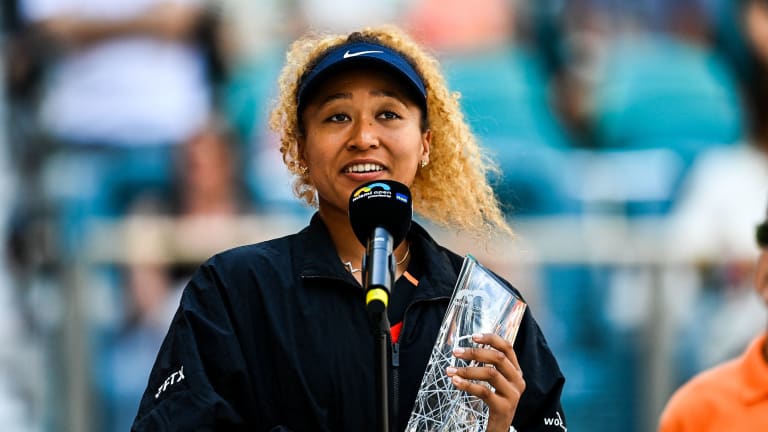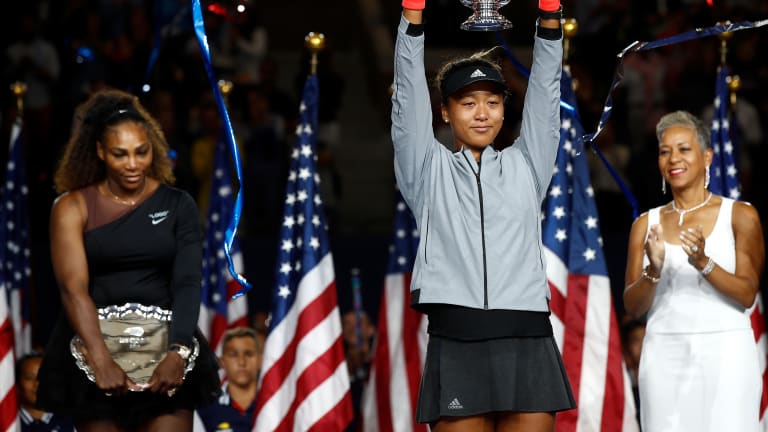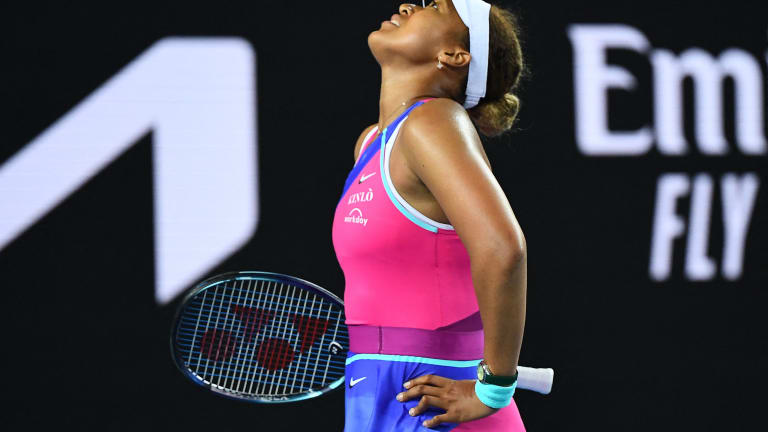Has tennis lost Naomi Osaka?
By Peter Bodo Nov 11, 2022After first-round Madrid loss, Naomi Osaka takes wild card to WTA 125 in France
By TENNIS.com Apr 25, 2025"Done with my crashout": Naomi Osaka ready for reset after losing Madrid opener
By Baseline Staff Apr 24, 2025Alexandra Eala to face Iga Swiatek in Madrid; Naomi Osaka loses clay-court opener
By Associated Press Apr 22, 2025Game, Set, Recharge: Globe-trotting tennis pros fight jet lag by staying one step ahead
By Stephanie Livaudais Apr 19, 2025Naomi Osaka teases more iconic tennis kits: 'Treating every Grand Slam like the Met Gala'
By Baseline Staff Apr 04, 2025'Brave' Magda Linette ousts Coco Gauff, Fils tops Tiafoe on tough Monday in Miami for U.S.
By TENNIS.com Mar 25, 2025Jack Draper, Coco Gauff and Naomi Osaka all in action: Miami, Day 5 Preview
By Steve Tignor Mar 22, 2025Naomi Osaka vs. Hailey Baptiste: Where to Watch, Miami Open Preview, Betting Odds
By TENNIS.com Mar 21, 2025Naomi Osaka vs. Liudmila Samsonova: Where to Watch, Miami Open Preview, Betting Odds
By Steve Tignor Mar 20, 2025Has tennis lost Naomi Osaka?
Recent bouts of alienation have left the tennis world questioning the young star's future, and her commitment to the game.
Published Nov 11, 2022
Advertising
After Naomi Osaka turned 25 in mid-October, she took to Instagram to thank the legions of well-wishers who left her congratulatory birthday messages. Her own post concluded with the words, “I really don't know what I did to deserve it all. Love you and I’m sure I'll see you around.”
Advertising
Scores of fans and pundits determined that this was a coded message announcing an imminent comeback. Others, weary of Osaka’s ambivalence toward her profession and the drama accompanying it, saw the words as banal and non-committal: Maybe we’ll bump into each other at the mall, or at a Lakers game, the nail salon, or a library. Maybe we won’t. Whatever.
The only thing we know for sure is that, following a run to the Miami Open final this year, Osaka’s discontent with tennis mushroomed and her results grew dismal. She won just two completed matches after Miami, and vanished from view after a brief, appearance in Tokyo mid-September.
What was more alarming to many—including clued-up insiders— is that Osaka, a former No. 1 with four Grand Slam singles titles, has since gone dark, tennis-wise. Even her public Instagram account, which features plenty of glam shots and selfies, has been devoid of tennis-related content since the US Open.
Has tennis lost Osaka for good? And, if so, how?

Osaka's runner-up finish in Miami, and her status as a major-title contender, feels like a very long time ago.
© AFP via Getty Images
Advertising
“I haven’t heard anything about Naomi since the Open,” Zina Garrison told me. The former Wimbledon finalist and co-host—with Chanda Rubin—of the podcast, The Goat: Serena, added: “She literally went dormant.”
Pam Shriver, now an analyst for the Tennis Channel and ESPN, is equally nonplussed.
“I wish I had more of an inside understanding,” Shriver told me. “But what got pushed back to me talking about it is that Naomi doesn’t really want to be out there. Whether or not this is just a phase during which she’s sorting out her mental health issues, or building a brand, or something different remains to be seen.”
8/ “I do hope that people can relate and understand it’s O.K. to not be O.K., and it’s O.K. to talk about it.”
— TIME (@TIME) July 8, 2021
Read the full piece by @naomiosaka here https://t.co/c2ePmiV6ih pic.twitter.com/x2fknoqRXa
Advertising
What is obvious is that Osaka was caught up in a perfect storm that has heavily impacted her career. Diffident and unprepared for overnight stardom, she has been rocked by a series of unexpected events that now look like stepping stones to alienation. But she has also ignored or misunderstood some requisites of her career, moved into a spotlight she may not be designed to handle, and turned away from the community of her profession. As a further complication, Osaka has already earned life-transforming wealth that freed her from material reliance on tennis.
There appeared to be no need for guard rails during Osaka’s rise, beginning in 2016 through most of 2018, from a newbie who was church-mouse shy and charmingly quirky into an imperious champion. But the script blew up on a sultry, late-summer evening in 2018 when Osaka and her childhood idol, Serena Williams, clashed in the US Open final.
The competitive match was marred by an ugly, third-set controversy between Williams and chair umpire Carlos Ramos. The fracas completely overshadowed Osaka’s ultimate victory, leaving the 20-year-old in tears, so confused that during the trophy presentation she apologized to the crowd for holding her nerve, fending off the massive distractions, and winning the title.
“I’m sorry,” Osaka told the crowd during the trophy presentation. “I know that everyone was cheering for her (Williams), and I’m sorry that it had to end like this.”

Osaka was in tears after beating Serena Williams in the 2018 US Open final, but not out of joy.
© 2018 Getty Images
Advertising
Osaka went on to win the next major, the 2019 Australian Open, but many believe that Osaka’s unpleasant experience of 2018 just festered, emerging over time as, in Shriver’s words, “a real trauma.” Other puzzling signs included Osaka’s break immediately after that win in Melbourne with her coach, Sascha Bajin. She played poorly the rest of the year, but salvaged it with a strong finish.
The pandemic shutdown kept Osaka, and most everyone else, off the court for nearly seven months. They returned to a different world in which tournaments were held without spectators, under restrictive health protocols, and amid social justice protests raging across the United States. Moved to activism, Osaka became one of the most visible sports heroes to protest against predatory policing.
Although Osaka would go on to win the 2020 US Open and fourth major in Australia a few months later, the events of that pandemic summer had thrust her into a greater spotlight. She came under closer scrutiny. She was asked more probing, consequential questions. She was becoming something for which she had no talent: a public figure. Distractions, including those wrought by her activism, and a burgeoning resume contributed to the pressures building inside Osaka.
Those forces came to a head at the 2021 French Open, where Osaka declared that she would skip her mandatory post-match press conferences. Grand Slam officials united swiftly to threaten her with suspension if she ignored the mandate. While the players expressed sympathy for Osaka, they largely expressed no beef with the press requirements. Within hours, Osaka backtracked and shifted her emphasis, citing mental health as the underlying issue behind her threat. It launched a global conversation that raced like wildfire around the sporting world. Numerous elite athletes stepped forward to tell their own stories of mental struggles.
Advertising
“I don’t think the French Open situation was handled well by the tournament, or the other majors,” Patrick McEnroe, the ESPN analyst, told me when I was a guest on his recent Holding Court podcast. “They were essentially threatening Osaka with suspension as opposed to trying to help a person in need. I don’t think she ever recovered from that. Just look at her results.” (Osaka is 19-12 with no titles since then.)
One tour insider who chose not to be identified speculated that the “trigger” for Osaka’s alienation was the rescheduled Summer Olympic Games that took place in Tokyo at the end of July 2021. Osaka, who had not played since the French Open fracas, was chosen over some other, highly decorated Japanese athletes for the honor of lighting the Olympic cauldron. It was an odd decision, given Osaka’s absence from tennis, mounting woes and presumed antipathy to the limelight. She lit the cauldron, but disappointed Japan with a desultory, third-round loss to No. 41 ranked Marketa Vondrousova.
Other incidents soon followed. At the ensuing US Open, Osaka had a racquet-pitching emotional meltdown during her loss to rookie Leylah Fernandez. In her post-match presser, Osaka announced that tennis no longer made her “happy” and announced another break from the game. When Osaka returned earlier this year, a third-round loss at the Australian Open dropped her ranking to No. 85. At Indian Wells, a heckler brought Osaka to tears. The only bright spot was the Miami Open final—even then, a 6-4, 6-0 loss to Iga Swiatek—which was followed by a blizzard of losses and withdrawals due to injury. (Osaka withdrew before or retired during five of her matches in 2021 and 2022, some leading to lengthy absences.) Her current ranking is No. 42.

“Serena possessed a unique talent and a lot of confidence,” Patrick McEnroe says. “But I don’t think that anyone in their 20s can be a part timer.”
© AFP via Getty Images
Advertising
“I think she (Osaka) can bounce back with the right people around her,” Garrison says. “They have to show her it’s okay to be whoever you want to be, because if all your life experience is in tennis, you’re in a box. You need that experience of the outside world to grow as a person. She needs a team to help her figure that out. It’s not going to happen just by itself.”
Shriver’s takeaway from Osaka’s first-round US Open loss to an in-form Danielle Collins was that if Osaka hoped to rebuild, she must play more.
“Naomi needs to get back on the tour, back to the job,” Shriver says.
A good team would be helpful, but one of the concerning aspects in play is that any tennis infrastructure Osaka once had seems to have disappeared. She burned through a series of coaches and was last guided by her father. There’s no sign of a supportive partner. Her engagement with the tennis community appears minimal.
“For a career to work,” McEnroe said, “You need to be immersed in what tennis is about—for better or worse. Many of us lifers love it, even though we distance ourselves from the game some of the time. Tennis may be just a part of our life, that’s okay. But it’s an integral part.”
The Wiliams sisters were deservedly praised for expanding their horizons and developing interests beyond tennis. Osaka may be taking her cues from them, but Naomi Osaka is no Serena Williams. The younger Williams sister loved to play tennis, to compete. Often over the last two years it seemed that competition was the last thing Osaka craved.
“Serena possessed a unique talent and a lot of confidence,” McEnroe says. “But I don’t think that anyone in their 20s can be a part timer.”
Osaka may be trying out new identities, which is a prerogative of youth. There’s a movie producer hat, an actress hat, an Instagram celebrity hat, and a wide range of pitch-woman hats provided by numerous companies. For one professing to be painfully shy, Osaka certainly gets around in the public space. The implied contradiction therein is less a criticism than a sign of Osaka’s own confusion.
“My personal opinion is that Naomi is struggling to find out who she is, and she maybe knows who she wants to be,” Garrison said. Herself an African-American woman who navigated through an overwhelmingly white world with great success, Garrison believes that bi-racial individuals (Osaka’s father is Haitian, her mother Japanese) sometimes have to work through an identity crisis.
Advertising
“There’s a lot of searching for who I am, where do I fit in?,” Garrison said, ‘Then you add the three different countries, the different languages. . . the number of homes she has lived in. You can see how she would like to find out who she really is.”
It isn’t too late for Osaka to find resolution about the role of tennis in her life, perhaps even to make a comeback that rekindles the lost joy and exhausted appetite. The coming year looms as a pivotal one. Meanwhile, the tennis community waits, wondering if the rise and fall of Naomi Osaka in tennis is a completed saga.
“The handwriting isn’t on the wall yet,” McEnroe said. “We don’t know what she wants to do. She probably doesn’t know either.”